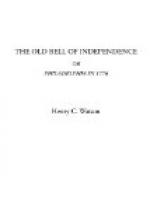“With this machine a skilful operator could swim so low on the surface of the water, as to approach at night very near to a ship without being discovered. After sinking quickly, he could keep at any necessary depth, and row to a great distance in any direction, without coming to the surface. Bushnell found, however, that much trial and instruction were required for a man of common ingenuity to become a skilful manager. It was first tried by his brother, who, unfortunately, was taken ill at the time when he had become an able operator. Another person was procured, and the first experiment tried upon the Eagle, a sixty-four, which Lord Howe commanded in person. He went under the ship, and attempted to fix the wooden screw into her bottom, but struck, as was supposed, a bar of iron running from the rudder-hinge. Not being well skilled in the management of the machine, he lost the ship in attempting to move to another place; and, after seeking her in vain for some time, rowed a little distance and rose to the surface. Daylight had now advanced so that the attempt could not be renewed, and, fearing he was discovered, he detached the magazine from his vessel and escaped. In an hour the powder exploded, throwing a vast column of water to an amazing height, and leaving the enemy to conjecture whether it was caused by a bomb, a water-spout, or an earthquake. Want of resources obliged Mr. Bushnell to abandon his schemes for that time; but, in 1777, he made an attempt from a whale-boat against the Cerberus frigate, by drawing a machine against her side with a line. It accidentally became attached to a schooner and exploded, tearing the vessel in pieces. Three men were killed, and one dangerously wounded.
“In December, 1777, Mr. Bushnell contrived another ingenious expedient for accomplishing his favorite object. He charged a number of kegs with powder, arranging them so as to explode on coming in contact with anything while floating along the tide. This squadron was launched at night on the Delaware river, above the English shipping; but, unfortunately, the proper distance could not be well ascertained, and they were set adrift too far from the vessels, so that they became obstructed and dispersed by the floating ice. On the following day, however, one of them blew up a boat, and others exploded, occasioning the greatest consternation among the British seamen. The troops were aroused, and, with the sailors, manned the wharves and shipping at Philadelphia, discharging their cannon and small-arms at everything they could see floating in the river during the ebb tide.




